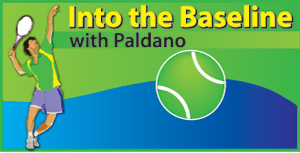Speed and more speed tennis, where is it?
View(s):In early Victorian days of tennis, playing surface, racquets and the ball were basic and nothing like what we have now. These kept the speed down in tennis. In player development, ball control and the consistency achieved were the parametres of success. At one instant overhead service criticised because of its speed. Speed not considered as a skill, umpire had to toss the ball to start the rally in royal courts. Placing the service court next to the net did restrict service speed. It does so even now.
Surging speed of tennis
 In the past five decades, speed in tennis has become the primary contributing factor to win. Sighting [eye], stroke skills, tactical positioning and tactical adaptability are speed oriented. It is so in Singles and Doubles.
In the past five decades, speed in tennis has become the primary contributing factor to win. Sighting [eye], stroke skills, tactical positioning and tactical adaptability are speed oriented. It is so in Singles and Doubles.
Recent tennis court, racquets, balls and player development target speed singularly. In interactive sports, providing time to opponent is a disadvantage. Playing tactics and speed are the attractions of tennis. So much so, service speed shown soon after the serve for the immediate excitement in a stadium court.
Measuring speed
Service speed is measured when ball crossing the net. It is a high tech, systematically measured at courtside and revealed immediately in the stadium. Working for accuracy will be sacrificing speed and working for speed will affect consistency accuracy, this has been so and will remain so.
In men, service speed has reached 240 and women 200 kilometres per hour. Such a service will reach the receiver in one third of a second and most groundstrokes in half of second. A player may execute up to 3000 shots in a match under these constrains.
When a player acquires stroke-making competencies, it is time for speed phase training. Player development is a long road.
Player development
Well-developed player losing happens all the time, underdeveloped player winning also happens: this is confusing, but mostly better player wins in tennis.
Daniils Medvedev’s success: what is the catch? He is not impressive but highly effective, in fact deadly. So is Iga Swiatek, WTA No.1. In the history of the game, the ability to handle speed has given immense reward. These players have that ability to take and deliver speed more than visual perfection in stroke making.
Stroke making
Defining stroke making has never been easy, yet it is the central theme of player development. Effectiveness of stroke making lies in the ability to receive and deliver speed keeping the court constrains. Many development fails in this aspect.
Service speed history of last 30 years shows placement to be of less important than speed. To my memory, Mike Sangster of England had the fastest serve with the wooden racquet. Synthetic era names are Arthurs Ash, Jimmy Connors, Bjorn Borg, John McEnroe, Pete Sampras, Boris Becker, Andre Agassi, Ivan Lendl, Rafael Nadal and Roger Federer come to mind. Similar strait developed in women tennis too, speed peaking with Maria Sharapova and Serena Williams. Present Top 10 of WTA ranking are super athletes and the march is getting stronger by the year.
Chinese Olympic gold medal
Qinwen Zheng, winning the gold medal in Paris, is a boost to Chinese women and they are bound to use it promoting tennis again. Li Na was the last Chinese Grand Slam winner and the wave she created did not sustain itself. [Bad publicity involving a tennis player and it made the Chinese women withdraw].
Asian swing
In the past, after US Open the last of the Grand Slam, professional Tennis went to a recess. The slot was free, not so now. China has taken the slot and has made it to the Asian swing. This year China had five WTA events and four ATP events after US Open. They were top end events with attractive prize money. Their stadiums are full when ATP and WTA staged events. However, the participatory popularity is lagging behind in China, still an expensive game in China.
Bounce back players
The final of the WTA yearend event will be in Riyadh, Saudi Arabia. The eight qualified are Iga Swiatek, Aryna Sabalenka, Jessica Pegula, Coco Gauff, Elena Rybakina, Jasmini Paolini, Quinwen Zheng, Emma Navaro. Stand by will be Danielle Collins according to WTA ranking.
Three WTA injured players showing signs of resurfacing. Barbora Kejicova threw everything into her singles after breaking up with her partner Katerina Siniakova. Kerjicova ranked 10 in the WTA list. Paula Badosa and Anna Kalinskaya on their comeback spell are climbing up. Both are in the top 15 bracket.
A credit worthy performer this year is Jelena Osterpenko, ranked one in Doubles and 15 in Singles. This Latvian has made her mark WTA tennis. Her game is simple and grit to perform is extraordinary. A model not often found in professional tennis.
–George Paldano, European and Asian competition player; Coach German Tennis Federation; National coach Brunei and Sri Lanka; Davis Cup, Federation Cup coach, coached ATP, WTA and ITF ranked players in Europe and Asia; whatsApp +94775448880–


